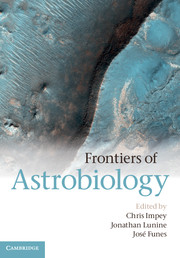Book contents
- Frontmatter
- Contents
- List of contributors
- Part I Introduction
- Part II Origin of Planets and Life
- Part III History of Life on Earth
- Part IV Habitability of the Solar System
- 8 Early Mars – Cradle or Cauldron?
- 9 Large Habitable Moons
- 10 Small Habitable Worlds
- Part V Exoplanets and Life in the Galaxy
- Index
- Plate Section
- References
10 - Small Habitable Worlds
from Part IV - Habitability of the Solar System
Published online by Cambridge University Press: 05 December 2012
- Frontmatter
- Contents
- List of contributors
- Part I Introduction
- Part II Origin of Planets and Life
- Part III History of Life on Earth
- Part IV Habitability of the Solar System
- 8 Early Mars – Cradle or Cauldron?
- 9 Large Habitable Moons
- 10 Small Habitable Worlds
- Part V Exoplanets and Life in the Galaxy
- Index
- Plate Section
- References
Summary
Introduction
The astrobiological relevance of small bodies has been acknowledged for several decades with regard to their role in delivering volatiles to Earth and the inner Solar system (see Lunine 2006 for a review). However, until recently these objects were considered too small to sustain a deep liquid layer and hydrothermal activity over the long term. The last decade has been marked by a dramatic evolution of our understanding of small bodies, from observational constraints and theoretical arguments. The discoveries of geological activity on Saturn's satellite Enceladus and Pluto's satellite Charon have prompted theoreticians to develop new approaches for modeling the interiors of these objects, some of which are larger and/or warmer than Jupiter's satellite Europa, considered an archetype of a potentially habitable icy world. The purpose of this chapter is to evaluate the habitability potential of certain small bodies, i.e. their potential for sheltering life, whether life could develop in these environments, or was brought in from a different source.
This chapter focuses on large wet asteroids, small icy satellites, and trans-Neptunian objects (e.g. see the representatives of each class in Figure 10.1). We evaluate the occurrence in each class of objects of certain parameters that determine their capacity to sustain habitable conditions: the energy necessary to support chemical activity and chemical conditions amenable to the thriving of living organisms. The latter aspect is difficult to fully fathom as life has been found in the most surprising environments and based on unexpected nutrient systems. The question of the origin of life in favorable environments is considered in Chapter 2.
- Type
- Chapter
- Information
- Frontiers of Astrobiology , pp. 201 - 228Publisher: Cambridge University PressPrint publication year: 2012
References
- 7
- Cited by



